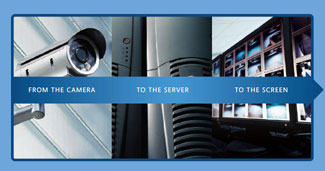REDMOND, Wash. — Oct. 7, 2010 — If you’ve ever caught yourself watching an old late-night mystery movie in which a crime has been committed, you can usually expect to hear one thing — “Did we get any evidence on tape?” Cut to a scene with investigators reviewing an old VHS tape that holds the contents of the security camera, and you’ve got yourself a typical movie cliché.
With the emergence of new technologies to monitor what’s happening in places of business, these old analog-based solutions are becoming extinct. As a result, enterprises — like the U.S. Department of Homeland Security, gaming, public safety, education and transportation — are quickly placing more value on software in security and surveillance products, and Windows Embedded Server is a key piece to this new way of thinking.
As noted in the first feature story from this series, Windows Embedded Server ensures that OEMs can build and deploy dedicated server appliances and solutions that businesses expect.

Windows Embedded Server helps bring content from the camera to the screen.
A great example of a company leveraging the power of Windows Embedded is Pivot3, a leader in storage-centric computing that needed an embedded operating system for its video surveillance market to enable its customers to run video management system software. After considering a wide variety of solutions, Pivot3 chose to leverage Windows Embedded Server’s configurations, management tool and support resources to assess its customers’ needs.
So how exactly does Windows Embedded Server assist with video surveillance from point of capture to actually getting in front of the necessary parties? For starters, it works in the back end to capture critical data using devices like card readers and IP cameras (which leverage Windows Embedded Compact 7), and converts the information into a digital transmission.
Once data is captured, the information moves to a video management system or recorder and gets housed in a database (which utilizes Windows Embedded Server). From there, videos can be streamed to monitoring devices, which use Windows Embedded Enterprise or Windows Embedded Standard 7, for live or recorded review.
Been to Vegas lately? One of the most interesting examples of Pivot3 and Windows Embedded working together is the Silverton Hotel and Casino.
“We were looking for a highly reliable operating system that would be easy to install, configure and manage for both typical IT shops and physical security integrators who are less familiar with computing technology,” said Lee Caswell, chief marketing officer and founder, Pivot3. “Our customers want to utilize a wide variety of best-of-breed ISV applications for video management, access control, video analytics and more. They don’t want to worry about whether their favorite applications will run or not — they simply expect them to run.”
Want to read more about how Pivot3 leverages Windows Embedded Server for companies like the Silverton Hotel and Casino? We invite you to check out the case study here. We also encourage you to read this case study on NICE Systems, a leading provider of advanced video surveillance solutions, and how it utilizes Windows Embedded Server for an enterprise-class, scalable IP video solution.
You can learn more about Windows Embedded Security and Surveillance solutions here.
Be sure to keep an eye on the Windows Embedded News Center in the next few weeks for additional Windows Embedded Server stories focusing on the medical, industrial automation and telecom industries. Stay tuned to the @msftweb Twitter handle for the latest updates from the Windows Embedded team.




